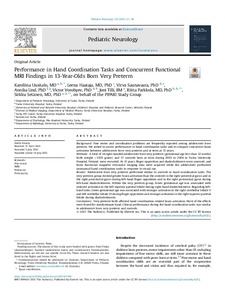Performance in Hand Coordination Tasks and Concurrent Functional MRI Findings in 13-Year-Olds Born Very Preterm
Uusitalo Karoliina; Haataja Leena; Saunavaara Virva; Lind Annika; Vorobyev Victor; Tilli Joni; Parkkola Riitta; Setänen Sirkku; PIPARI Study Group
https://urn.fi/URN:NBN:fi-fe2021093048256
Tiivistelmä
Background
Fine motor and coordination problems are frequently reported among adolescents born preterm. We aimed to assess performance in hand coordination tasks and to compare concurrent brain activation between adolescents born very preterm and at term at 13 years.
Methods
A total of 34 right-handed adolescents born very preterm (gestational age less than 32 weeks/birth weight ≤1500 grams) and 37 controls born at term during 2003 to 2006 in Turku University Hospital, Finland, were recruited. At 13 years, finger opposition and diadochokinesis were assessed, and brain functional magnetic resonance imaging data were acquired while the adolescents performed unimanual hand coordination tasks in response to visual cue.
Results
Adolescents born very preterm performed similar to controls in hand coordination tasks. The very preterm group evoked greater brain activation than the controls in the right precentral gyrus and in the right postcentral gyrus during left-hand finger opposition and in the right postcentral gyrus during left-hand diadochokinesis. Within the very preterm group, lower gestational age was associated with reduced activation in the left superior parietal lobule during right-hand diadochokinesis. Regarding left-hand tasks, lower gestational age was associated with stronger activation in the right cerebellar lobule V and left cerebellar lobule VI during finger opposition and stronger activation in the right superior parietal lobule during diadochokinesis.
Conclusions
Very preterm birth affected hand coordination-related brain activation. Most of the effects were found for nondominant hand. Clinical performance during the hand coordination tasks was similar in adolescents born very preterm and controls.
Kokoelmat
- Rinnakkaistallenteet [27094]
